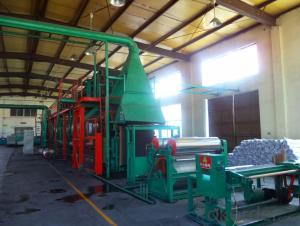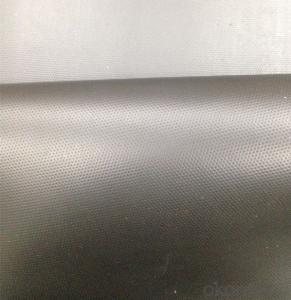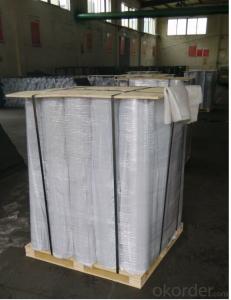EPDM Rubber Waterproof Membrane 1.2mm, 1.5mm, 2mm CMAX
- Loading Port:
- Qingdao
- Payment Terms:
- TT OR LC
- Min Order Qty:
- 4000 m²
- Supply Capability:
- 200000 m²/month
OKorder Service Pledge
OKorder Financial Service
You Might Also Like
EPDM Rubber Waterproof Membrane
Product Instruction:
EPDM waterproof membrane is made from ternary ethylene-propylene rubber,which is designed for waterproofing of exposed and non-exposed applications. EPDM waterproof membrane is of high elasticity among high polymer waterproof materials and becomes a world-popular waterproofing material.
CNBM own the wold-advanced equipment of cold feeding extrusion and continuous vulcanization technology. With the best performance among high polymer waterproof materials, EPDM is of exceptional elasticity and will not split or cracked under normal building movement.
Product Features:
-Excellent weather-ability, durability and size stability
-Good adaptability to high and low temperature, UV resistant and anti-corrosion
-High tensile strength and good elongation, accommodating to structure movement
-Easy installation, solid joint, and mo environmental pollution
-Good rooting penetration resistance
-Service life up to 50 years
Applications:
-Roof, basement, tunnel, pond liner, dam
-Industrial and civil building waterproofing
-Geosynthetic liner for fish ponds, swimming pools, channels, irrigation system
-Especially suitable for projects with high requirement in durability, anti-corrosion and deformation
Specifications:
-Width of roll: 1.2m, 2m, 4m
-Length of roll: 20m, 30m or customized
-Thickness of membrane: 1.2mm, 1.5mm, 2mm
-Type: vulcanized EPDM or welding EPDM
-Application: roof, basement, pond, lake, swimming pool, steel structure roofing, underground, tunnel, etc
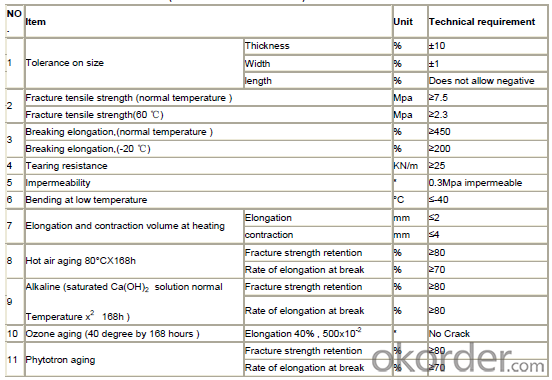
FAQ:
1. Is your EPDM waterproof membrane the real rubber?
Yes, our EPDM membrane is made from top quality rubber, which is imported from America. We support samples for testing, or testing in our factory.
2. How's your products quality?
Our EPDM is with the top quality at home and abroad. Our quality is much higher than Chinese standard. Our product is widely used in Chinese Central government projects. And it's also accpted by customers all over the world, such as EU, USA, Astrulia, etc.
3. What's the service life of your EPDM membrane?
The service life of our EPDM membrane is more than 50 years.
4.What's your MOQ?
Our MOQ is 3000M2.
5. What's your product ability of EPDM membrane?
We own the largest EPDM production line in China. Our product ability of EPDM membrane reaches 2 million square meter per year.
Photos:
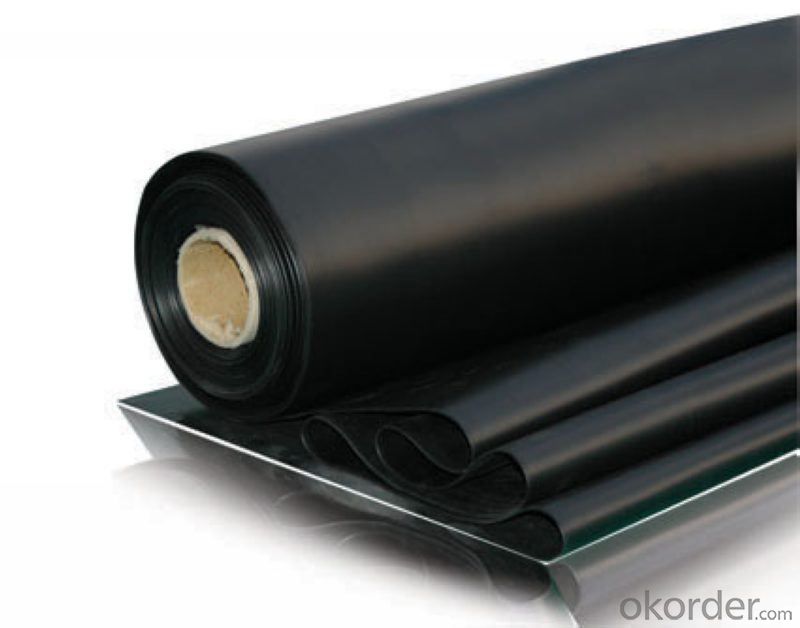
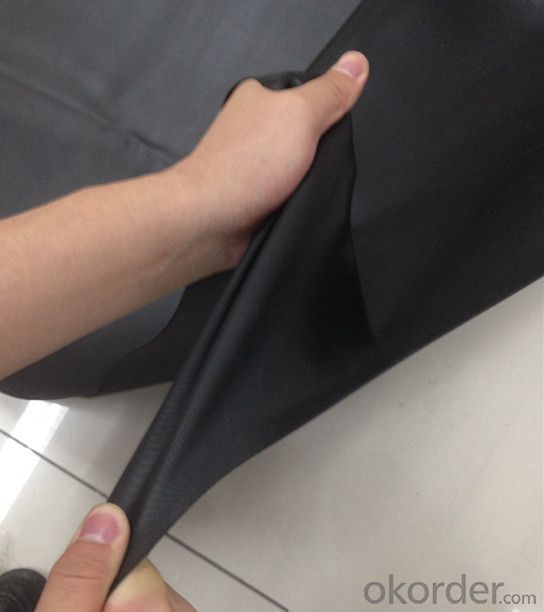


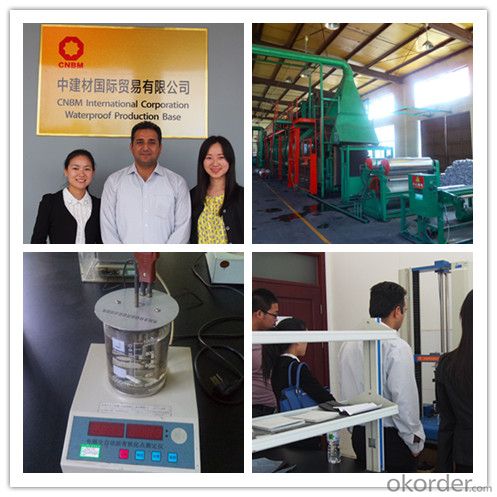
- Q:Is a waterproofing membrane environmentally friendly?
- Yes, a waterproofing membrane can be considered environmentally friendly. Waterproofing membranes are designed to prevent water leakage and damage to structures, which can contribute to the longevity of a building and reduce the need for repairs or replacements. This can result in a reduction in construction waste and the overall environmental impact of the building industry. Furthermore, some waterproofing membranes are made from eco-friendly materials, such as recycled content or bio-based materials, which can help reduce the carbon footprint associated with their production. Additionally, these membranes can be designed to be recyclable or biodegradable, further reducing their environmental impact at the end of their life cycle. Moreover, by preventing water infiltration, waterproofing membranes can help protect the structural integrity of buildings, preventing moisture-related issues such as mold growth and rot. This can contribute to maintaining a healthy indoor environment and reducing the need for energy-intensive remediation measures. It is important, however, to consider the specific characteristics and certifications of a waterproofing membrane to assess its environmental friendliness accurately. Look for certifications such as LEED (Leadership in Energy and Environmental Design) or products that have undergone life cycle assessments to ensure that they meet rigorous environmental standards. In summary, while not all waterproofing membranes may be inherently environmentally friendly, the use of certain materials and the prevention of water damage can make them a sustainable choice for building projects.
- Q:Does a waterproofing membrane provide any insulating properties?
- A waterproofing membrane does not offer any insulation. Its main purpose is to stop water or moisture from entering a building or roof. It acts as a protective barrier, preventing damage to the underlying materials. Insulation, on the other hand, is specifically designed to minimize the transfer of heat, sound, or electricity. While both waterproofing and insulation are crucial for maintaining a structure's integrity and functionality, they serve distinct purposes and should not be mistaken for each other.
- Q:Can a waterproofing membrane be used for a bathroom?
- Yes, a waterproofing membrane can be used for a bathroom. In fact, it is highly recommended to use a waterproofing membrane in bathrooms to prevent water damage and leakage. A waterproofing membrane acts as a barrier that prevents water from seeping into the underlying structure, such as the walls or floors. This is particularly important in areas where there is frequent exposure to water, such as showers and bathtubs. By installing a waterproofing membrane, you can ensure that your bathroom remains dry, preventing any potential damage to the structure or the growth of mold and mildew.
- Q:Does a waterproofing membrane require any specialized tools or equipment for installation?
- Yes, the installation of a waterproofing membrane typically requires specialized tools and equipment. Some of the common tools and equipment used for installation include a trowel or roller for spreading the membrane, a utility knife for cutting and shaping the membrane, a heat gun or propane torch for activating and adhering the membrane, a seam roller for ensuring proper bonding of seams, and a caulking gun for applying sealant around penetrations and edges. Additionally, depending on the specific type of waterproofing membrane being installed, other tools such as a primer, bonding adhesive, or specialized membrane fasteners may be required. It is important to consult the manufacturer's installation guidelines to ensure the proper tools and equipment are used for a successful installation.
- Q:Can a waterproofing membrane be installed over existing coatings or sealants?
- Yes, a waterproofing membrane can be installed over existing coatings or sealants. However, it is important to assess the condition and compatibility of the existing coatings or sealants before installation to ensure proper adhesion and long-term performance of the waterproofing system.
- Q:Are waterproofing membranes resistant to UV rays?
- Yes, waterproofing membranes are typically designed to be resistant to UV rays. They are formulated with additives and coatings that provide protection against the damaging effects of sunlight and ensure long-term durability and performance.
- Q:Can a waterproofing membrane be applied to tiled surfaces?
- Certainly! A tiled surface can indeed receive the application of a waterproofing membrane. In reality, it is customary to utilize a waterproofing membrane beneath tiled surfaces, particularly in regions susceptible to moisture like bathrooms, showers, and kitchen backsplashes. The waterproofing membrane serves as a shield, thwarting water infiltration into the foundation, thereby safeguarding both the tiles and the underlying structure against water-related harm. Before applying the waterproofing membrane for best outcomes, it is crucial to ensure that the tiled surface is adequately prepared and devoid of any fissures or impairments.
- Q:Waterproof building materials after the construction of drums, bubble is what reason?
- Reason 2: Construction, due to the construction of the membrane waterproof layer of paving is not true, so that part of the empty, remain in which to form a bubble. Control measures: in the asphalt waterproofing membrane construction, the first surface of the coil clean. When laying the web, the mastic should be painted evenly and carefully compaction work to enhance the cohesive force between the web and the base, the web and the web. High polymer modified asphalt waterproofing membrane construction, the flame heating to be uniform, full, moderate. Paving to roll forward while hot, while rolling with a pressure roller to exclude the air below the coil.
- Q:Can waterproofing membranes be used on utility manholes?
- Utility manholes can indeed benefit from the use of waterproofing membranes. These specialized membranes are specifically engineered to create a barrier against water infiltration, making them perfectly suited for areas where water is present, such as manholes. To prevent any potential damage to the structure or the utilities within, these membranes are typically applied to the walls and floors of the manhole, effectively preventing water from seeping through. This process not only maintains the integrity and functionality of the utilities, but also helps to avoid water-related issues like corrosion, leaks, and material degradation. Furthermore, waterproofing membranes offer additional protection against elements such as chemicals, gases, and soil contaminants that may be found in or around the manhole. Thus, the application of waterproofing membranes on utility manholes is a widely adopted practice to guarantee their long-term durability and functionality.
- Q:Can a waterproofing membrane be used for a hotel?
- Indeed, a hotel can benefit greatly from the utilization of a waterproofing membrane. Commonly employed in construction, waterproofing membranes serve as a protective measure against water damage. When it comes to hotels, these membranes can be applied to a multitude of areas, including the roof, foundation, basements, bathrooms, and balconies, effectively averting water leakage and moisture infiltration. Particularly in locales prone to water exposure, such as swimming pools, spa facilities, or regions with heavy rainfall or high humidity, the installation of a waterproofing membrane becomes paramount. By integrating this measure into a hotel, the structural integrity of the building can be upheld, the growth of mold and mildew can be thwarted, and a comfortable and secure environment can be ensured for guests.
1. Manufacturer Overview |
|
|---|---|
| Location | |
| Year Established | |
| Annual Output Value | |
| Main Markets | |
| Company Certifications | |
2. Manufacturer Certificates |
|
|---|---|
| a) Certification Name | |
| Range | |
| Reference | |
| Validity Period | |
3. Manufacturer Capability |
|
|---|---|
| a)Trade Capacity | |
| Nearest Port | |
| Export Percentage | |
| No.of Employees in Trade Department | |
| Language Spoken: | |
| b)Factory Information | |
| Factory Size: | |
| No. of Production Lines | |
| Contract Manufacturing | |
| Product Price Range | |
Send your message to us
EPDM Rubber Waterproof Membrane 1.2mm, 1.5mm, 2mm CMAX
- Loading Port:
- Qingdao
- Payment Terms:
- TT OR LC
- Min Order Qty:
- 4000 m²
- Supply Capability:
- 200000 m²/month
OKorder Service Pledge
OKorder Financial Service
Similar products
New products
Hot products
Related keywords

